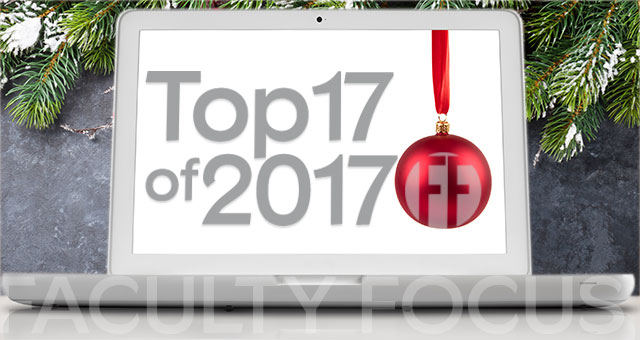As another year draws to a close, the editorial team at Teach Strats looks back on some of the most popular articles of the year. Throughout 2017, we published more than 200 articles, covering a wide range of teaching and learning topics, including assignment strategies, cell phone policies, course design, flipped classrooms, online discussions, study strategies, and grading policies.
In this, our last post of the year, we reveal the top 17 articles for 2017. Each article’s ranking is based on a combination of factors, including e-newsletter open and click rates, social shares, reader comments, web traffic, reprint requests, and other reader engagement metrics.
17. Using Metacognition to Reframe our Thinking about Learning Styles
Helping students discover who they are as learners and how learning works can create opportunities for deeper and more integrative learning to occur.
16. An Activity That Promotes Engagement with Required Readings, Even in Large Classes
Encouraging students to read what’s assigned is an age-old problem. This activity motivates students to complete the readings and engage at a deeper level.
15. Let’s Practice What We Teach: Flipping Faculty Development
Can we flip faculty development? Can we design faculty-centered learning experiences much the same way we design student-centered learning experiences?
14. Synchronous Online Classes: 10 Tips for Engaging Students
Online courses are increasingly holding synchronous sessions. Here’s how to increase engagement, participation, and accountability during virtual meetings.
13. Students’ Self-Fulfilling Prophecies: Five Ways to Break the Cycle
How can I support students to move beyond negative past experiences and make positive ones? How can I empower students to break these cycles?
12. Where’s the Curiosity?
It’s curiosity that goes beyond the facts to ask not only how and where, but when—and most importantly—why. I don’t see that kind of curiosity very often.
11. A Challenge to Current Grading Practices
These aren’t easily implemented reforms, but that shouldn’t prevent us from considering small changes that move assessment practices in these directions.
10. Towards a ‘Positive U’
Students who feel stressed have trouble concentrating and learning. Here are five things teachers can do to create a more positive classroom climate.
9. Three Ideas for Implementing Learner Reflection
Reflection has been one of the most commonly used pedagogical tools across a wide variety of disciplines, but most students don’t take to it naturally.
8. Questioning the Two-Hour Rule for Studying
Faculty often tell students to study two hours for every credit hour, but if we want to develop self-directed learners, that admonition should change.
7. How Should I Study for the Exam?
A brief quiz helps students identify the study strategies associated with higher exam grades and those that students propose using to improve on the next exam.
6. How Should We Respond to Student Entitlement?
Literature on student entitlement covers a lot of ground–what it is, what causes it, whether it’s new. But what’s missing is how should faculty respond.
5. Three Reasons to Ditch Technology in Your Flipped Classroom
The flipped classroom doesn’t require a lot of technology. It’s about involving students in the process of learning. Here are three activities to consider.
4. Participation Points: Making Student Engagement Visible
Engaged learners are active learners, but how do we help our students shift from grade seekers to knowledge seekers? A participation rubric can help.
3. Study Strategies for Before, During, and After Class
Students direct the majority of their energy to learning material after class, which causes an unnecessary cycle of complication. Here’s a better option.
2. Helping Students Make the Right Call on Cell Phones
What does it take to get students to put down their phones and focus on classroom activities? Less than you’d think. Read about one professor’s experiment.
1. A Memo to My Students as the New Semester Begins
A professor writes a memo to her students on how they can help create a positive learning experience, starting with being physically and mentally present.

